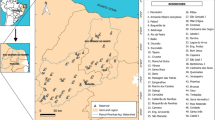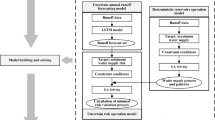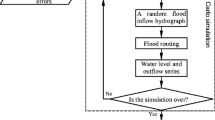Abstract
Reservoirs play a major role as an essential source of surface water, especially in arid and semi-arid regions. To optimize the operation of a reservoir and determine its storage, which varies in time, the uncertainties of major influencing factors such as its inflow and evaporation should be considered. The objective of this study is to examine the effects of joint uncertainties of the inflow and evaporation of Durudzan reservoir on its performance for the first time. The Monte Carlo simulation is used for uncertainty assessment. Specifically, the monthly time series of inflow and evaporation were generated by using artificial neural networks and the standard operation policy was used for reservoir operation. Furthermore, the probabilistic distributions of four performance indices, including time-based reliability, volumetric reliability, vulnerability, and resiliency were calculated to assess the effects of the joint uncertainties of inflow and evaporation as well as the physical parameters on the reservoir variables (e.g., water release, storage, and spill). The results showed that the highest and lowest uncertainties of the reservoir water release occurred in July and May, respectively. In addition, the highest and lowest uncertainties were, respectively, observed in March and October for the reservoir storage, and in March and May for the water spill. The results also showed that the volumetric reliability had the highest uncertainty with a coefficient of variation (CV) of 0.158, while the resiliency had the lowest uncertainty with a CV of 0.020.












Similar content being viewed by others
Data Availability Statement
All of the required data have been presented in our article.
References
Akbari-Alashti, H., Bozorg-Haddad, O., Fallah-Mehdipour, E., & Mariño, M. A. (2014). Multi-reservoir real-time operation rules: A new genetic programming approach. Proceedings of the Institution of Civil Engineers: Water Management, 167(10), 561–576. https://doi.org/10.1680/wama.13.00021
Araghinejad, S. (2013). Data-driven modeling: Using MATLAB® in water resources and environmental engineering. Springer Science and Business Media.
Asgari, H.-R., Bozorg-Haddad, O., Pazoki, M., & Loáiciga, H. A. (2016). Weed optimization algorithm for optimal reservoir operation. Journal of Irrigation and Drainage Engineering, 142(2), 04015055. https://doi.org/10.1061/(ASCE)IR.1943-4774.0000963
Ashofteh, P.-S., Bozorg-Haddad, O., & Loáiciga, H. A. (2019). Application of bi-objective genetic programming for optimizing irrigation rules using two reservoir performance criteria. International Journal of River Basin Management. https://doi.org/10.1080/15715124.2019.1613415 in Press.
Bai, Y., and Jin, W.-L. (2016). Random variables and uncertainty analysis. Marine Structural Design, 615–625.
Bozorg-Haddad, O., (2018). “Water Resources Systems Optimization.” Tehran university Publication, No.3, Tehran, Iran.
Bozorg-Haddad, O., Athari, E., Fallah-Mehdipour, E., Bahrami, M., & Loáiciga, H. A. (2019). Allocation of reservoir releases under drought conditions: A conflict-resolution approach. Proceedings of the Institution of Civil Engineers: Water Management, 172(5), 218–228.
Bozorg-Haddad, O., Azad, M., Fallah-Mehdipour, E., Delpasand, M., & Chu, X. (2020). Verification of FPA and PSO algorithms for rule curve extraction and optimization of single- and multi-reservoir systems’ operations considering their specific purposes. Water Supply. https://doi.org/10.2166/ws.2020.274
Bozorg-Haddad, O., Farhangi, M., Fallah-Mehdipour, E., & Mariño, M. A. (2014). Effects of inflow uncertainty on the performance of multireservoir systems. Journal of Irrigation and Drainage Engineering, 140(11), 04014035.
Bozorg-Haddad, O., Moradi-Jalal, M., Mirmomeni, M., Kholghi, M. K. H., & Mariño, M. A. (2009). Optimal cultivation rules in multi-crop irrigation areas. Irrigation and Drainage, 58(1), 38–49. https://doi.org/10.1002/ird.381
Bozorg-Haddad, O., Zarezadeh-Mehrizi, M., Abdi-Dehkordi, M., Loáiciga, H. A., & Mariño, M. A. (2016). A self-tuning ANN model for simulation and forecasting of surface flows. Water Resources Management, 30(9), 2907–2929. https://doi.org/10.1007/s11269-016-1301-2
Chang, L. C., & Chang, F. J. (2009). Multi-objective evolutionary algorithm for operating parallel reservoir system. Journal of Hydrology, 377(1–2), 12–20.
Cigizoglu, H. K. (2008). Artificial neural networks in water resources. In H. G. Coskun, H. K. Cigizoglu, & M. D. Maktav (Eds.), NATO Science for peace and security series C: Environmental security (pp. 115–148). Springer. https://doi.org/10.1007/978-1-4020-6575-0_8
Cremon, M. A., Christie, M. A., and Gerritsen, M. G. (2018). “Monte Carlo Simulation for Uncertainty Quantification in Reservoir Simulation: A Convergence Study. In: Conference proceedings, ECMOR XVI - 16th european conference on the mathematics of oil, pp.1 - 18.
Delli Priscoli, J. (2000). Water and civilization: Using history to reframe water policy debates and to build a new ecological realism. Water Policy, 1(6), 623–636. https://doi.org/10.1016/s1366-7017(99)00019-7
Delpasand, M., Bozorg-Haddad, O., & Loáiciga, H. A. (2020). Integrated virtual water trade management considering self-sufficient production of strategic agricultural and industrial products. Science of the Total Environment. https://doi.org/10.1016/j.scitotenv.2020.140797
Delpasand, M., Fallah-Mehdipour, E., Azizipour, M., Jalali, M., Safavi, H. R., Saghafian, B., Loáiciga, H. A., Babel, M. S., Savic, D., & Bozorg-Haddad, O. (2021). Forensic engineering analysis applied to flood control. Journal of Hydrology, 594, 125961.
Du, Y.-C., & Stephanus, A. (2018). Levenberg-Marquardt neural network algorithm for degree of arteriovenous fistula stenosis classification using a dual optical photoplethysmography sensor. Sensors, 18(7), 2322. https://doi.org/10.3390/s18072322
Duckstein, L., & Plate, E. J. (Eds.). (1987). Engineering reliability and risk in water resources. Springer. https://doi.org/10.1007/978-94-009-3577-8
Ehsani, N., Fekete, B. M., Vörösmarty, C. J., & Tessler, Z. D. (2015). A neural network based general reservoir operation scheme. Stochastic Environmental Research and Risk Assessment, 30(4), 1151–1166. https://doi.org/10.1007/s00477-015-1147-9
Fallah-Mehdipour, E., Bozorg-Haddad, O., & Mariño, M. A. (2015). Evaluation of stakeholder utility risk caused by the objective functions in multipurpose multireservoir systems. Journal of Irrigation and Drainage Engineering, 141(2), 04014047. https://doi.org/10.1061/(ASCE)IR.1943-4774.0000785
González-Manteiga, W., & Crujeiras, R. M. (2013). An updated review of goodness-of-fit tests for regression models. TEST, 22(3), 361–411. https://doi.org/10.1007/s11749-013-0327-5
Hashimoto, T., Stedinger, J. R., & Loucks, D. P. (1982). Reliability, resiliency, and vulnerability criteria for water resource system performance evaluation. Water Resources Research, 18(1), 14–20.
Iyer, M. S., & Rhinehart, R. R. (1999). A method to determine the required number of neural-network training repetitions. IEEE Transactions on Neural Networks, 10(2), 427–432. https://doi.org/10.1109/72.750573
Jain, S. K., Das, A., & Srivastava, D. K. (1999). Application of ANN for reservoir inflow prediction and operation. Journal of Water Resources Planning and Management, 125(5), 263–271. https://doi.org/10.1061/(asce)0733-9496(1999)125:5(263)
Jain, S. K., Reddy, N. S. R. K., & Chaube, U. C. (2005). Analysis of a large inter-basin water transfer system in India. Water and Energy Abstracts, 15(2), 32–32.
Jothivenkatachalam, K., Nithya, A., & Mohan, S. C. (2010). Correlation analysis of drinking water quality in and around perur block of Coimbatore District, Tamil Nadu, India. Rasayan Journal of Chemistry, 3(4), 649–654.
Karamouz, M., and Araghinejad, Sh. (2011), “Advanced Hydrology”, Industrial university of Amir Kabir publication, No. 2, Tehran, Iran.
King, L. M., & Simonovic, S. P. (2020). A deterministic Monte Carlo simulation framework for dam safety flow control assessment. Water, 12(2), 505.
Lee, J., Lee, M., Chun, Y.-Y., & Lee, K. (2018). Uncertainty analysis of the water scarcity footprint based on the AWARE model considering temporal variations. Water, 10(3), 341. https://doi.org/10.3390/w10030341
Liu, X., Lu, C., Zhu, Y., Singh, V. P., Qu, G., & Guo, X. (2017). Multi-objective reservoir operation during flood season considering spillway optimization. Journal of Hydrology, 552, 554–563.
Loucks, D. P., Stedinger, J. R., & Haith, D. A. (1981). Water resource systems planning and analysis Prentice-Hall Englewood Ciiffs NJ. Hydrological Science, 41(5), 697–713.
Loucks, D. P., and van Beek, E. (2005). Water Resources Systems Planning and Management: An Introduction to Methods, Models and Applications. In: Studies and Reports in Hydrology. UNESCO Publishing, Paris.
Lowe, L. D., Webb, J. A., Nathan, R. J., Etchells, T., & Malano, H. M. (2009). Evaporation from water supply reservoirs: An assessment of uncertainty. Journal of Hydrology, 376(1–2), 261–274.
Maity, R. (2018). Basic statistical properties of data. Springer transactions in civil and environmental engineering, 53–92. https://doi.org/10.1007/978-981-10-8779-0_3.
Marton, D., & Paseka, S. (2017). Uncertainty impact on water management analysis of open water reservoir. Environments, 4(1), 10.
McMillan, H., Seibert, J., Petersen-Overleir, A., Lang, M., White, P., Snelder, T., & Kiang, J. (2017). How uncertainty analysis of streamflow data can reduce costs and promote robust decisions in water management applications. Water Resources Research, 53(7), 5220–5228.
Okon, A. N., Adewole, S. E., & Uguma, E. M. (2020). Artificial neural network model for reservoir petrophysical properties: Porosity, permeability and water saturation prediction. Modeling Earth Systems and Environment. https://doi.org/10.1007/s40808-020-01012-4
Rolke, W., & Gongora, C. G. (2020). A chi-square goodness-of-fit test for continuous distributions against a known alternative. Computational Statistics. https://doi.org/10.1007/s00180-020-00997-x
Seifollahi-Aghmiuni, S., Bozorg-Haddad, O., & Loáiciga, H. A. (2016). Development of a sample multiattribute, multireservoir system for testing operational models. Journal Irrigation and Drainage Engineering, 142(1), 04015039.
Shokri, A., Bozorg-Haddad, O., & Mariño, M. A. (2013). Algorithm for increasing the speed of evolutionary optimization and its accuracy in multi-objective problems. Water Resources Management, 27(7), 2231–2249. https://doi.org/10.1007/s11269-013-0285-4
Soltanjalili, M., Bozorg-Haddad, O., & Mariño, M. A. (2011). Effect of breakage level one in design of water distribution networks. Water Resources Management, 25(1), 311–337. https://doi.org/10.1007/s11269-010-9701-1
Soundharajan, B.-S., Adeloye, A. J., & Remesan, R. (2016). Evaluating the variability in surface water reservoir planning characteristics during climate change impacts assessment. Journal of Hydrology, 538, 625–639.
Srdjevic, B., Medeiros, Y. D. P., & Faria, A. S. (2004). An objective multi-criteria evaluation of water management scenarios. Water Resources Management, 18(1), 35–54.
Tegegne, G., & Kim, Y.-O. (2020). Representing inflow uncertainty for the development of monthly reservoir operations using genetic algorithms. Journal of Hydrology, 586, 124876.
Tehrani, M., Samani, J., & Montaseri, M. (2008). Uncertainty analysis of reservoir sedimentation using latin hypercube sampling and Harr’s method: Shahar Chai Dam in Iran. Journal of Hydrology (New Zealand), 47(1), 25–42.
Willis, R., Finney, B. A., & Chu, W.-S. (1984). Monte Carlo optimization for reservoir operation. Water Resources Research, 20(9), 1177–1182.
Xu, C.-Y., & Singh, V. P. (1998). A review on monthly water balance models for water resources investigations. Water Resources Management, 12(1), 20–50. https://doi.org/10.1023/a:1007916816469
Zhang, X., Liang, F., Srinivasan, R., & Van Liew, M. (2009). Estimating uncertainty of streamflow simulation using Bayesian neural networks. Water Resources Research. https://doi.org/10.1029/2008WR007030
Zhao, T., Cai, X., & Yang, D. (2011). Effect of streamflow forecast uncertainty on real-time reservoir operation. Advances in Water Resources, 34(4), 495–504.
Acknowledgements
The authors thank Iran’s National Science Foundation (INSF) for the support for this research.
Author information
Authors and Affiliations
Corresponding author
Ethics declarations
Conflict of interest
The authors declared that they have no conflict of interest.
Additional information
Publisher's Note
Springer Nature remains neutral with regard to jurisdictional claims in published maps and institutional affiliations.
Rights and permissions
About this article
Cite this article
Bozorg-Haddad, O., Yari, P., Delpasand, M. et al. Reservoir operation under influence of the joint uncertainty of inflow and evaporation. Environ Dev Sustain 24, 2914–2940 (2022). https://doi.org/10.1007/s10668-021-01560-4
Received:
Accepted:
Published:
Issue Date:
DOI: https://doi.org/10.1007/s10668-021-01560-4




